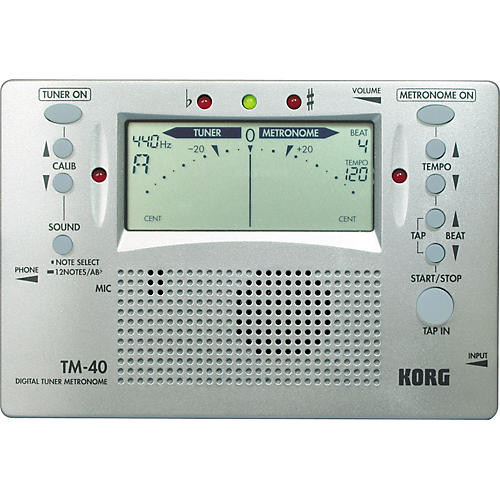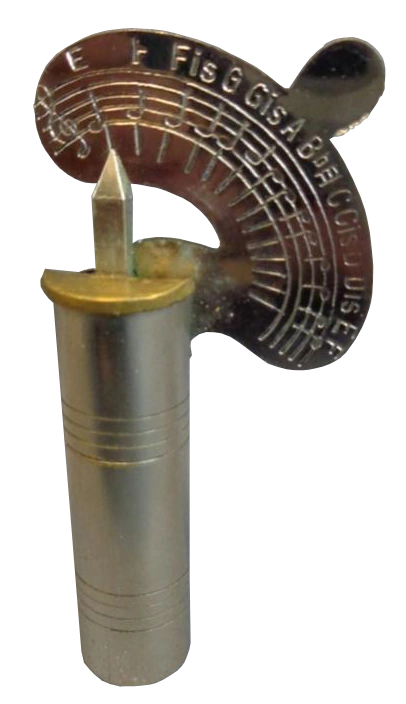


Today, when a musician sits down to tune, he or she probably pulls out just pulls out an electronic tuner, turns it on, and then makes the necessary adjustments until the little needle on the display points to A440Hz, the standing tuning pitch for the majority of the world (Source). Or, if they;re a real tech-savvy musician, they’ll whip out the latest smartphone and open up their tuning app, watching as the red frowny face goes to the bright green smiley face. That obviously differs by which app their using, but that app that smiles or frowns based on how in tune the instrument is, is probably one of the most popular.
Yet, just a few decades ago, tuning was much more difficult than simply opening an app or turning on a pocket-sized electronic device. Recently, Penn State’s Symphonic Band director, who is at most 60 years old, became quite disgusted with the poor tuning of the Symphonic Band. “Back in my day,” he exclaimed, sounding like the typical older person, “the oboist would hit her leg with a tuning fork, she’d play the A and tune to the fork, and everyone else would join in. You all have electronics that make it so much easier now, so I see no reason that you should be this far out of tune!” The idea of tuning with a tuning fork seems primitive and backwards to the modern musician, yet the director is only separated from the students by a few decades. This was the inspiration for this blog post, which will now explore past methods of tuning.
Just because it looked amazing, here’s what happens when you dip a vibrating tuning fork into water.
Before the invention of the tuning fork, musicians requiring a standard pitch utilized wooden pitch pipes (Source). Originally, these pitch pipes were rather like a recorder, with a plunger, known as a swanee whistle; this whistle had the notes of the chromatic or diatonic etched into it, and by setting it to the correct position, the instrument would produce that pitch for instrumentalists to tune to (Source). However, these pitch pipes are essentially instruments themselves and are technically part of the harmonica family. Because of this, and the fact that they were made out of wood, pitch pipes were rather unreliable because the wood varied by changes in its temperature and humidity (Source).
Due to the unreliability of wooden pitch pipes, it soon became apparent that some other means of tuning needed to be found, particularly as the movement to establish national and, ultimately, international standards of concert pitch (A440Hz) gained momentum (Source). Tuning forks were invented by John Shore in 1711 for the express purpose of tuning instruments (Source), though it would later find extensive use in science as well. Because it is made of metal and because of its overall design, the tuning fork is able to hold its pitch over a wide range of environmental conditions and produces a very pure tone, which is largely why it became so popular and became the standard until well into the 20th century (Source). When struck, tuning forks produce several tones (a fundamental and a harmonic) based on the length of the prongs of the fork. Longer prongs vibrate slower and produce lower pitches, while shorter prongs vibrate faster and produce higher pitches (Source).
Here is a brief demo on tuning forks. While it mainly focuses on the physics of them, it does provide a good visual of how they are used and how altering them can change the sounds that they produce.
As aforementioned, tuning forks would remain the standard for tuning until well into the 20th century, when they were replaced by modern electronic tuners. Interestingly enough, the standard concert pitch that is so widely used did not come into widespread use until the late 19th century, and musicians instead listened closely and tuned to one another until they reached a pitch that sounded good enough and close to what the entire ensemble was playing at. In fact, the first attempt to standardize A440Hz was a conference organized by Joseph Goebbels in 1939, as he had already established it as the official tuning pitch of German music while he was minister of propaganda in Nazi Germany (Source). Due to the outbreak of the war, the agreement did not last long. A second attempt was made in 1953, and again in 1971 (Source). No official standard was ever established by any conference, but by now, the majority of ensembles tune to A440Hz, with the exception of ensembles in Moscow which frequently, “revel in a plushy, warm tone achieved by a larynx relaxing A=435 cycles” (Source).
Thus, even with the widespread use of tuners and the ease and accessibility provided by electronic tuners, musicians need to rely on the tuner that nature provided them with: their ears. At the heart of everything is listening. Failure to listen causes discord and waves; beautiful dissonances become crunchy chords that make everyone cringe. While it might be cliche, perhaps this is the way that mankind can fix so many of its problems: listening. If we’d all just listen to each other a little bit more, we’d be more in tune with each other, our harmonies would be better, and maybe we’d finally learn how to get along.
Thank you to anyone that has read this post and who has followed my blog. It’s been a pleasure writing this blog and learning all these things. Have a great rest of your year, and I hope your college careers go well!
This blog post brought back so many good memories of having to call someone to come out to my house and tune our piano after the different seasons, temperature changes, moisture, and etc. had taken their toll on its tune. Thank you for sharing your love for music with us this semester!
I really enjoyed this blog. It’s so interesting to think about all of the science that goes behind the music we cherish so much. Learning about how tuning forks and resonance worked in physics always interested me a lot, and seeing you put everything together here is really concise. One topic that I’ve been intrigued by is how beat frequencies form, with a couple tuning forks at close frequencies, where they resonate at a frequency that is the difference between their frequencies. The timing of all those frequencies and properly making pitches is truly what makes music what it is, and there is so much science behind it all.
What is the third pitch pipe called. My grandfather has one and I want to get one but I can’t find it anywhere.